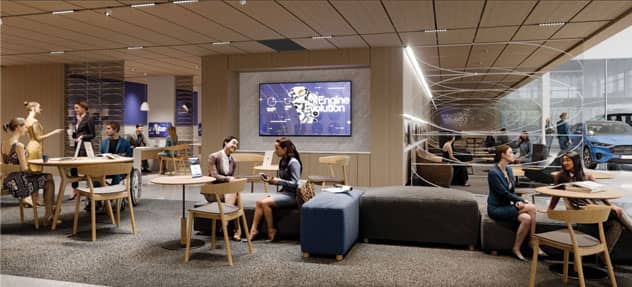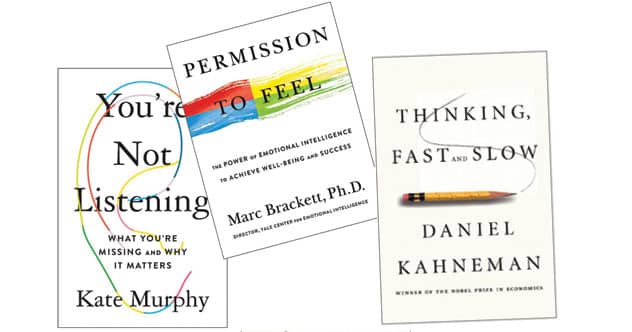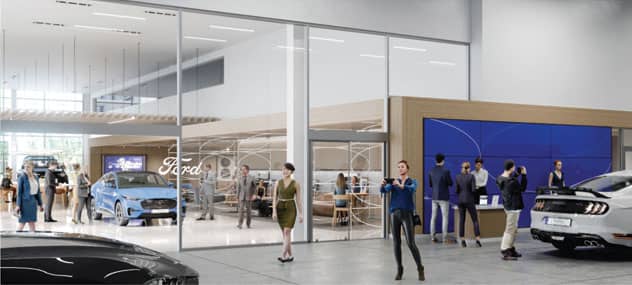INTERVIEW WITH JULIA CALABRESE, ASID
How do we want our
brands to make people feel? “That question is an excellent entry point for
designing any retail environment or experience,” says designer Julia
Calabrese.
For this installment of the Design & Designer series, Furniture World spoke
with Julia Calabrese, ASID, Global Design Manager, Ford Motor Company.
Calabrese was recently recognized by ASID as a rising leader in its 2022
Ones to Watch program. Her empathy-led, science-backed design philosophy has
applications in all types of retail, including home furnishings retailers.
Her Career Path
Calabrese’s career path might have landed her in the furniture industry as a
residential designer. “At the tail end of 2008, right in the middle of the
Great Recession,” recalled Calabrese, “I was on track to becoming a
residential interior designer. My parents were concerned about job
insecurity along that path, so I took their advice and enrolled at Eastern
Michigan University, majoring in psychology. About halfway through the
program, I reconsidered and enrolled at the Art Institute of Michigan,
graduating with a Bachelor of Fine Arts in Interior Design while working as
a design consultant at a Thomasville Furniture store.
“After graduation,” she continued, “I joined Czarnowski Collective, an
experiential marketing creative agency. There I worked closely with our
client General Motors to adapt GM’s brand presentations at auto shows to
specific international audiences in countries from Canada to Dubai. The plan
for each show, which varied in size and audience, was an expression of our
vision for the brand.”
Understanding Brand Design
“Many people understand brand design primarily in terms of logos, colors,
fonts and physical products. What we did at Czarnowski was relate the
essence of a brand to human experiences. We asked the question; How do we
want a brand to make people feel? And in turn, how do people actually feel
about that brand? Where is the intersection between the two, and how can we
use design to transition people from the feelings they already have about
it, to the feelings we want the brand to elicit?”
In 2017, Calabrese was hired by Ghafari Associates, a company that did
workplace strategy and design for Ford Motor Company. In 2020 she was named
Global Design Manager - Workplace and Retail at Ford.
“At the time, Ford was working on the first iteration of its Dearborn master
plan, which totally reinvented the way Ford employees work. I was hired to
help build a team of in-house designers and architects,” she recalled.
Home Furnishings Connection
Furniture World asked Calabrese how her experience in the auto industry is
relevant to home furnishings retailers and their customers.
“Brands and retailers in each of these industries require an understanding
of consumer behaviors and how to tell impactful stories about their brands,”
she replied. “It doesn’t matter if it’s automotive retail or furniture
retail. How brand stories are crafted is incredibly important.
 Pictured above is the “library area” design near the entrance of a Ford
pilot dealership in China, the result of a collaboration between Ford
and Ghafari. It has lowered ceilings, a hospitality bar and comfortable
upholstery to foster exclusivity. Elements of a typical retail
experience that elicit stress were removed to help give customers
permission to feel in control of the sales journey.
Pictured above is the “library area” design near the entrance of a Ford
pilot dealership in China, the result of a collaboration between Ford
and Ghafari. It has lowered ceilings, a hospitality bar and comfortable
upholstery to foster exclusivity. Elements of a typical retail
experience that elicit stress were removed to help give customers
permission to feel in control of the sales journey.
“To do it well requires an understanding of your brand’s purpose, its target
customers and of the emotions you want customers to feel about your brand.
With this framework in place, storytelling can build powerful emotional
connections.
“At Ford, getting to this understanding began with the company’s purpose
statement. Ford’s one-sentence statement, ‘To help build a better world,
where every person is free to move and pursue their dreams,’ was surgically
dissected to build the groundwork for meaningfully correlating Ford’s
purpose with emotions we planned to elicit through design.”
Building Human Connections
“Consumers increasingly seek out brands that align with their values. This
helps them to feel alive, heard and valued. Brands, in turn, can harness the
power that comes from building connections to individuals and communities to
create positive associations with consumers.”
Calabrese added that these emotions can be addressed at many levels
including showroom design at the level of employee-customer interactions.
“From the perspective of front-line retail associates, understanding how
your brand has decided to connect with customers and communities begins by
understanding the brand ethos. What is the brand’s essence? Why does it
exist? What’s its North Star?
“At Ford, we are considering how we can retrain dealership staff to approach
customers without preconceived notions about what shoppers are looking for
or who they are. In other words, to connect with empathy. The goal is to get
salespeople to come to the table with a mindset that they are there to help
build a community as opposed to just making a sale. How to get them to take
the time to listen and be empathetic is still a million-dollar question,”
she mused. “I believe that a good place to start the process in any
organization is at the top. That alone can reorient companies toward
promoting empathetic mindsets.”
Toward this end, Calabrese suggested that Furniture World subscribers read
“You’re Not Listening: What You’re Missing and Why It Matters” by Kate
Murphy, part of her suggested 2021-2022 reading list shown in the sidebar on
page 28.
Anthropology, Psychology...
Calabrese says that three disciplines, anthropology, psychology and
neurology, when considered together, provide the best potential to create
positive outcomes for any brand.
“The broad stroke transformation I most enjoy in the home furnishings
space is the emergence of confident consumers who don’t shop for what
matches or what’s predictable.”
“Neurology,” she explained, “has to do with the way our brains process
information—how they take in and perceive the world. It speaks to the
decision-making process people use to purchase a new sofa and what makes a
choice feel right. Psychology is the behavioral outcome of that process.
“The final piece of the puzzle is anthropology, which looks at communities
and groups of people. It helps us to understand why a particular geographic
region will likely be interested in a brand; its style, price-point,
sustainability profile or another feature.
Think Tank Solutions
“I recently moved from Detroit to Texas and furnished a home. The furniture
store experience wasn’t much different than when I worked as a design
consultant at Thomasville Furniture years ago. I haven’t seen a lot of
innovation in the way that furniture is sold, displayed, talked about and
engaged with in physical stores. There seems to be a lot of room for
improvement.”
Furniture World asked Calabrese to describe what Ford does to explore ways
to innovate. That can be a challenge for furniture retailers who grew up in
the industry, network with similar retailers and get information from their
reps.
“At Ford,” Calabrese responded, “to expand our field of view we’ve found
that hosting Think Tanks are an excellent way to move the needle forward.
Like many others in 2019 we were faced with a big question. What is the
future of work? To find out, we put together a think tank that included
roughly equal numbers of participants from Ford as well as subject matter
experts from outside the automotive industry.
“The external participants ranged from doctors and anthropologists to a
woman from NASA. Assembled were innovators in technology and experts in
collaboration tools. This diverse group brought with them a range of
experiences, backgrounds and knowledge we could never duplicate in-house.
The results were profound, and we were able to formulate a solution that
will take us through the next 50 years.
“Our last think tank was so successful that we’ve convened another one to
address the future of retail, bringing in people from Meta, as well as from
retail and the entertainment sectors. The only people that will not be
represented are those who have previous experience at other companies in the
auto industry because we don’t want to benchmark a competitor or apply
preconceived notions.”
She believes that if a brand is looking to disrupt its industry and deliver
transformational results, “an excellent place to start is by consulting with
a coalition of innovators.”
Julia Calabrese’s Reading List Suggestions for 2022

You’re Not Listening: What You’re Missing and Why It Matters
by Kate Murphy makes accessible the psychology, neuroscience, and
sociology of listening.
Permission To Feel
by Marc Brackett,Ph.D. Founding Director of the Yale Center for
Emotional Intelligence. A guide to understanding emotions and using
them wisely.
The Catalyst: How To Change Anyone’s Mind
by Jonah Berger. This book looks at why the most successful change
agents don’t push harder or provide more information. Instead they
become a catalyst for change with extraordinary results.
Thinking, Fast and Slow
by Daniel Kahneman. There are two systems for thinking. One is fast,
intuitive, and emotional. The other is slower, deliberative, and more
logical. Kahneman explains how people think and why they often fall
short.
Think Again: The Power Of Knowing What You Don’t Know
by Adam Grant. Organizational psychologist and Wharton Professor Adam
Grant is an expert on opening other people’s minds - and our own. His
book describes how to stay curious enough about the world to actually
change it.
Good to Great: Why Some Companies Make the Leap... And Others
Don’t
by Jim Collins. Collins shows his readers how good companies, mediocre
companies, even bad companies achieve enduring greatness.
Imaginable: How to See the Future Coming and Feel Ready for Anything
- Even Things That Seem Impossible Today
by Jane McGonigal.
Rational vs. Emotional Buying
Humans are emotionally driven beings. As much as they would like to think
that their vehicle or furniture purchases are driven by logic, the truth is
otherwise. Price point, durability and style might be just right, but
ultimately, it’s how people feel about the products they purchase that are
deciding factors.
“Most people think that they make fully rational buying decisions,” said
Calabrese, “but at the end of the day, brand choices usually come down to
how people feel when they enter a showroom, interact with customer service,
take a test drive or, in the furniture industry, sit on a sofa.
“Powerful emotions may come into play when a shopper sits in a vehicle that
they believe makes them look cool. Or, when they imagine what friends will
think when they first see their new dining set. What will these purchases
say about who they are? Too often retailers think in terms of product
features and merchandising lifestyles. I don’t think that the furniture
industry has focused on bridging the gap between the products they sell and
the emotions they want their customers to feel when they see, sit on and
purchase products.”
Emotions are also a key factor in driving people back into stores to replace
furniture, she observed. “After five years, a person might look at their
living room set and think, ‘This doesn’t fit who I am anymore.’ People ebb
and flow as human beings and that’s an opportunity to educate them about how
new items can fit into their lives, grow with them and make them feel.”
BEHR paint tapped into this idea recently with their “Festival Girl”
30-second television spot that advises, “If you don’t paint every now and
then, it’s like the old you is still hanging around.” Check out
here.
Community
“Two topics retailers from different industries have been intensely
interested in recently,” Calabrese continued, “are building authenticity and
building community.
“Community engagement activities include both reaching out to communities
and inviting them in. It’s about being an important presence, becoming a
recognized friendly face, creating potential customer contacts, building
trust and hiring locally. Doing this well can lead to a brand being
recognized as authentic, if its actions consistently reflect its brand
values.
“In addition to local efforts, having a robust presence on social media
helps brands to expand the boundaries of community to like-minded consumers
independent of geography, age, ethnicity or income.”
Emotional Showroom Design
A large part of the vehicle purchase process happens at dealer showrooms.
“Retail showrooms,” noted Calabrese “are stages that can be designed to
elicit positive emotional responses.
“For example, we recently made architectural modifications to a Ford
showroom located in China. The emotional goals we identified for the space
were to help people feel safe, comfortable and empowered. Successfully
eliciting these emotions can build trust in our brand and serve as a gateway
to customer loyalty.”
Entryway: Calabrese said that before it was renovated, when
customers entered the facility they were welcomed by a large, open area.
“The impressively high ceilings in this space had the potential to make
shoppers feel exposed and unprotected. The redesign included a baffled
canopy dropped over the main entrance. The baffles allowed the space to
remain light and transparent, while offering a sense of refuge upon entry.
Next, we removed all of the sales desks within the facility. It is more
common for shoppers to be confronted by desks in auto dealerships than in
furniture stores, but removing them from view, also provided space to insert
a hospitality bar. Going into an already uneasy situation, such as
negotiating a big-ticket car or home furnishings purchase, can be
intimidating for many people, especially women. Desks on a sales floor can
reinforce this emotional distress. Entering a sales office or finance office
and having somebody close the door behind you can make it even worse.”
Lounge Area: “Instead of having customers enter into a
potentially stressful space, we designed an area where customers could be
greeted and offered refreshments. It includes a hospitality bar and an area
we call ‘the library.’ To the left of the library, two products were
displayed that acted as an invitation to enter the main sales floor of the
showroom. This arrangement was designed to give shoppers the feeling that
they have the power to choose where and when they want to conduct business.
In other words, we encourage them to feel in control of the sales journey
and their experience. Historically, when a shopper walks into a car
dealership or a furniture store, they may feel like just the next ‘up.’ The
salesperson pops out of nowhere and says, ‘Hey, how are you doing? What can
I do for you?’
“This library area was designed to facilitate conversations in an open
environment where people can be seen and heard by others. The design
included a variety of seating choices, intentionally clustered to make
customers feel at home.”
The Studio: Another consideration Calabrese and her team
addressed was helping purchasers to build emotional relationships with
products. They created a design studio where purchasers could take samples
of leather and interior trim home with them.
“We called it a studio table,” she said. “The idea was to get their neurons
firing and connecting as they touch, smell and show their purchase to
friends and family—building a feeling of pride in their purchase even before
it arrives. This is anticipated to be a really big hit with consumers, who
we believe will form stronger emotional attachments to both products and the
brand.”
Customization: “We’re definitely seeing large increases in
terms of customization, creating cars that people feel are created
especially for them. So, whether it’s through storytelling or actual
customization, it’s clear that people are looking for a connection with the
products they shop.
“Similar to the emotional effects of the studio table initiative,” she
noted, “is keeping customers in the loop before, during and even after
delivery. The effect of continually reestablishing the value of the products
they’ve already bought in ways that connect their emotions to products is
substantial.”
Service: “In the car industry, there’s a lot of revenue
generation potential on the service side that’s not there for home
furnishings retailers,” observed Calabrese. “It doesn’t make sense to put
all this effort into telling stories and creating positive emotional content
only to erase all that work post-sale.”
For furniture retailers, post-sale service falls squarely on the cost side
of the equation. This can be a subtle disincentive to provide less than
stellar service or try too hard to get customers to accept solutions that
are not fully satisfactory.
“There’s a cost to not making customers feel valued and heard. Being
attentive to a service customer’s needs in terms of getting problems solved
quickly and easily makes it more likely that they’ll be a return customer
and tell their friends about their experience.”
 The goal of Ford’s service concept as illustrated in the rendering at
left is to equalize the sales and service experience.
The goal of Ford’s service concept as illustrated in the rendering at
left is to equalize the sales and service experience.
The Future
Julie Calabrese added some final thoughts for retailers going forward.
“Baseline, there is room for improvement with storytelling and human
connections in both the auto and furniture industries. We all know about the
big push by Meta (formerly Facebook), which has the potential to change the
way consumers make major purchases. It’s going to be very interesting.